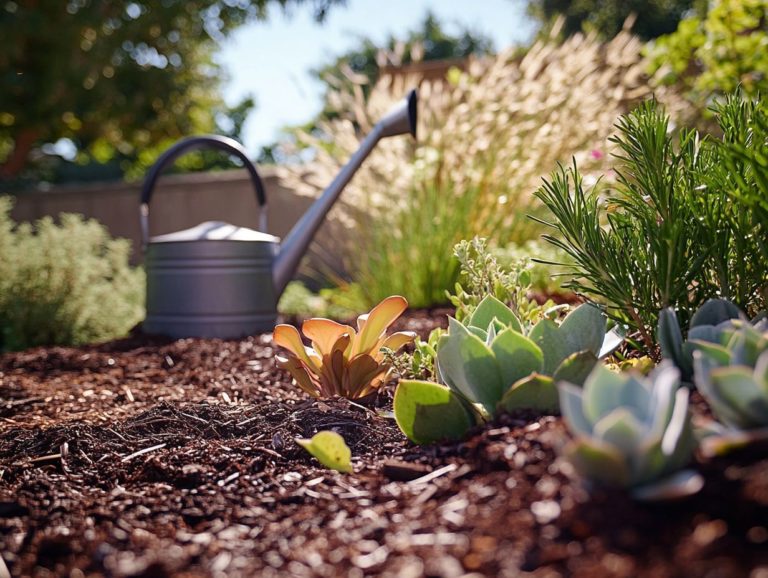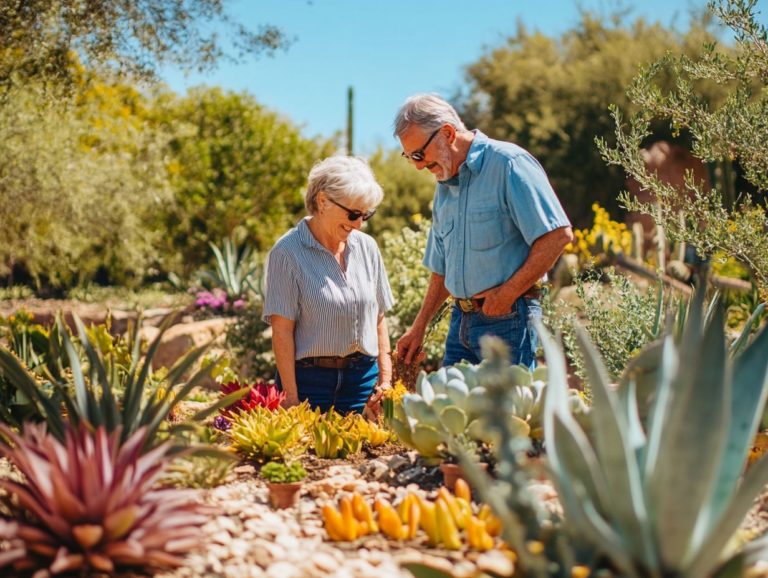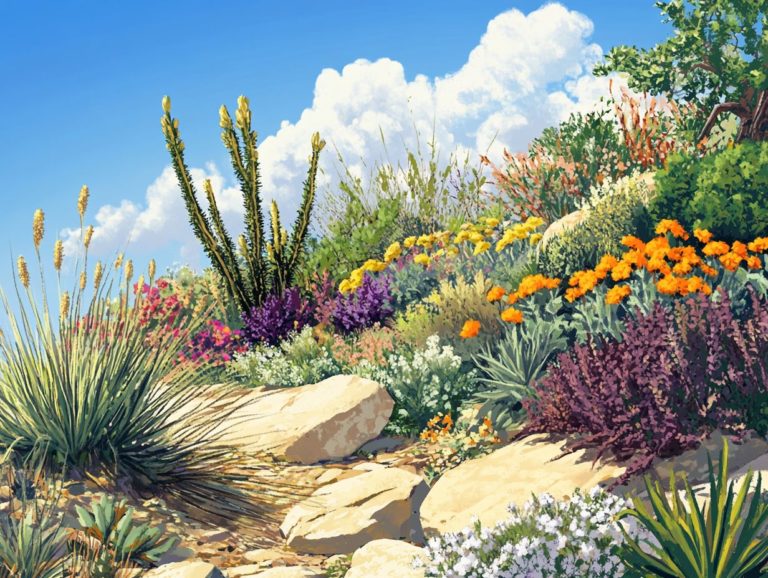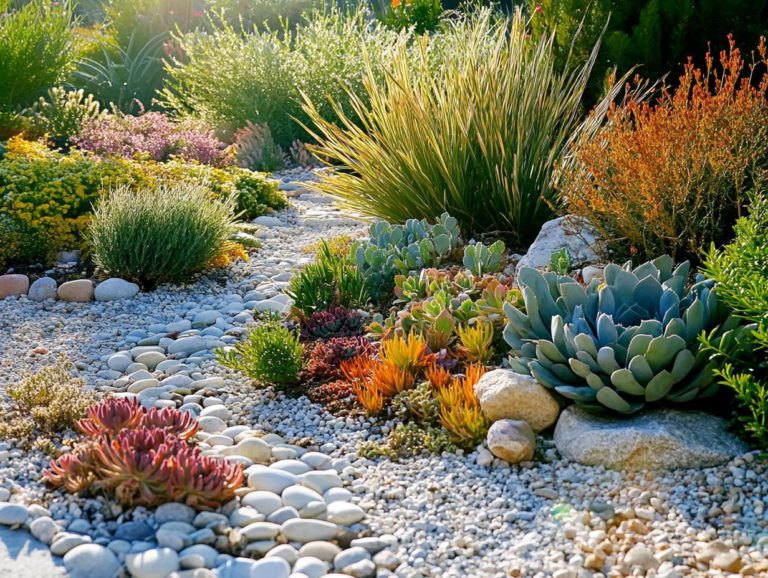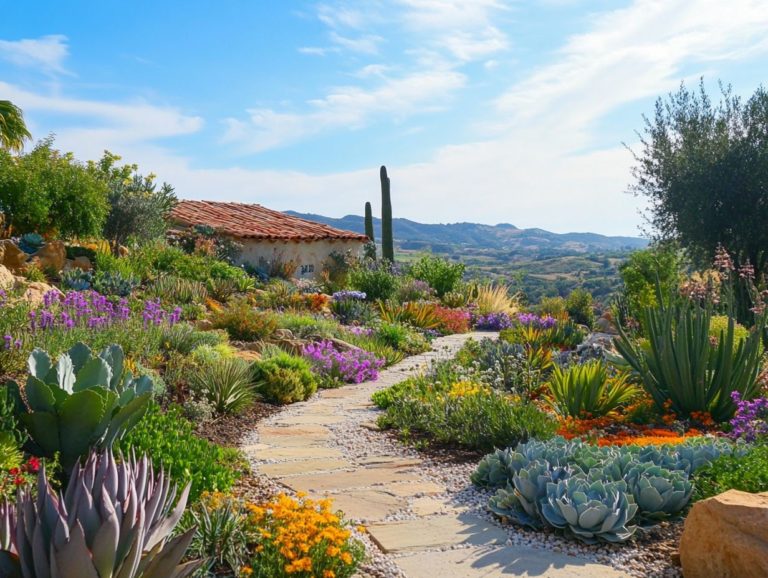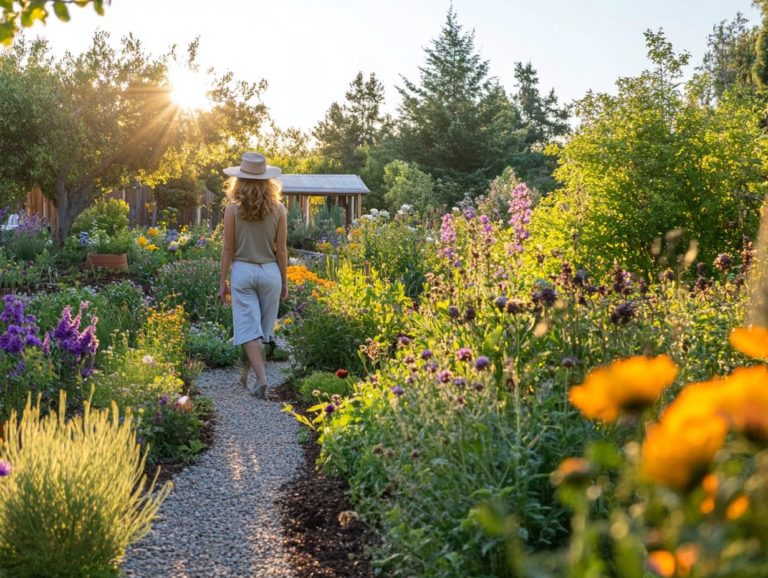Top 5 Drought-Resistant Flowers for Your Garden
Creating a vibrant garden doesn t have to mean endless hours of watering and maintenance. If you’re aiming to enhance your outdoor space while being mindful of water conservation, flowers that do well even when it’s dry are an exceptional choice.
Consider these five stunning options:
- Lavender
- Yarrow
- Coneflower
- Blanket Flower
- Sedum
These blooms thrive in tough conditions. Let s dive into how to care for these stunning flowers, what makes them attractive, and how they can elevate your garden while minimizing water usage.
It’s also important to discuss potential drawbacks, ensuring you’re well-informed. Now, let s explore the captivating world of resilient blooms!
Contents
- Key Takeaways:
- 1. Lavender
- 2. Yarrow
- 3. Coneflower
- 4. Blanket Flower
- 5. Sedum
- What Makes These Flowers Drought-Resistant?
- Frequently Asked Questions
- What are the top 5 drought-resistant flowers for my garden?
- Why should I choose drought-resistant flowers for my garden?
- How should I care for my drought-resistant flowers?
- Can I still have a colorful garden with drought-resistant flowers?
- Will these drought-resistant flowers attract pollinators?
- Are these drought-resistant flowers suitable for any type of garden?
Key Takeaways:
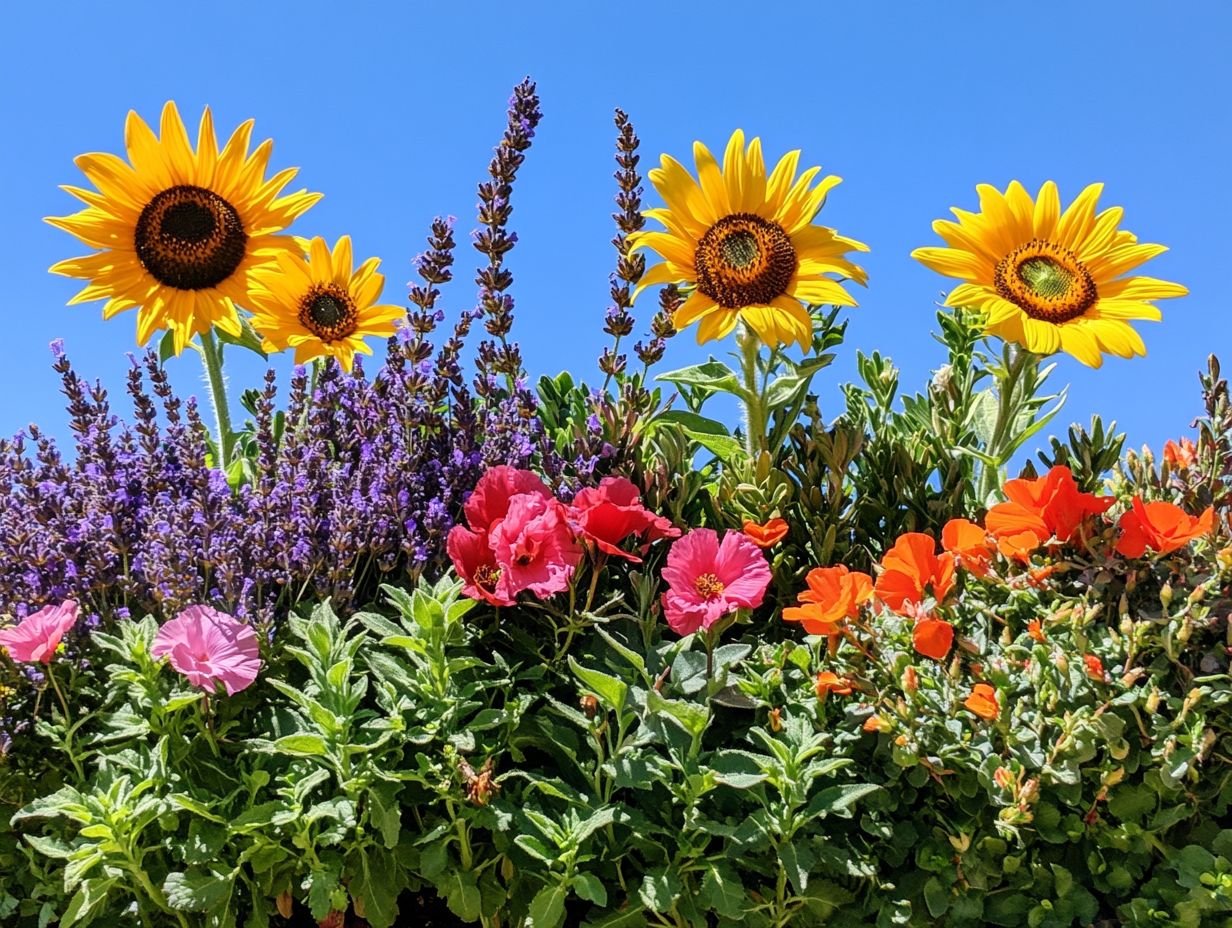
- Lavender, yarrow, coneflower, blanket flower, and sedum are the top 5 flowers that do well even when it’s dry.
- These flowers have adapted to survive in dry conditions and require little water and maintenance.
- Besides being low-maintenance, these flowers also attract pollinators, add color and texture to your garden, and can be found at most garden centers.
1. Lavender
Lavender is a quintessential choice for gardens that need little water. It s adored for its enchanting fragrance and exquisite purple blooms. It flourishes in full sun and good soil, making it a beloved option among both landscape designers and garden enthusiasts.
This versatile plant comes in various types, such as English, French, and Spanish lavender, each bringing its own distinct visual charm and aromatic allure. While care may differ slightly, all lavender varieties thrive under similar conditions: minimal moisture and abundant sunshine.
Lavender is also vital for attracting pollinators like bees and butterflies, enriching the ecosystem of your garden.
Expert Viveka Neveln suggests using a mix of lavender varieties to create dynamic color schemes. This way, these delightful plants blend seamlessly with the surrounding flora for a truly picturesque landscape.
2. Yarrow
Yarrow is a remarkable perennial that thrives in dry conditions, offering you a low-maintenance option for your garden. It charms a variety of pollinators with its vibrant blooms.
As a member of the Achillea family, yarrow includes many species, each showcasing unique traits. Among the favorites are Achillea millefolium and Achillea filipendulina. This resilient plant flourishes best in good soil and full sun, making it an ideal choice for dry landscapes.
When you pair yarrow with other low-water plants like lavender and sedum, you create a beautiful garden that conserves water and provides essential habitats for beneficial insects. Its feathery foliage and bright flower clusters elevate the visual allure of your garden beds and borders, resulting in a harmonious blend of color and texture.
3. Coneflower
Coneflower, or Echinacea, stands out as a resilient plant that thrives in hot, dry climates. Adding it to your garden is a smart move if you’re focused on water conservation and ecological balance.
With species like the purple coneflower and the white coneflower, you can infuse your landscape with vibrant colors while providing critical nectar sources for essential pollinators such as bees and butterflies. By incorporating coneflowers into your garden design, you ll enhance seasonal color, showcasing blooms in bright pinks to deep purples that peak from mid-summer to early fall.
To maximize their potential, consider planting them in clusters or alongside other native wildflowers. This approach creates visually striking combinations that bloom at different times for extended enjoyment. Plus, it supports your local ecosystem by attracting beneficial insects, making your garden a thriving haven for nature.
4. Blanket Flower

The Blanket Flower, scientifically known as Gaillardia, presents a stunning array of vibrant blooms that thrive in the summer heat, adding a splash of color to your garden while being remarkably durable and low-maintenance.
These charming flowers flourish in various soil conditions and only require moderate watering to thrive, making them the perfect choice for those with busy schedules. Their bold, daisy-like petals effortlessly attract a host of pollinators, including bees and butterflies, enhancing the biodiversity of your green space.
By incorporating these flowers into your landscape, you can craft a dynamic color scheme that evolves with the seasons, delivering delightful bursts of gold, red, and orange. Their resilience and beauty not only elevate the aesthetic appeal of your outdoor areas but also serve as an important part of local ecosystems, creating a harmonious environment for both flora and fauna.
5. Sedum
Sedum is a captivating collection of plants that can survive with little water that are perfect for container planting. Not only do they bring stunning blooms throughout the growing season, but they also attract a delightful array of wildlife.
With a wide range of varieties at your disposal, you might find yourself drawn to Sedum spectabile, celebrated for its breathtaking pink flowers and ability to thrive in full sun. Or perhaps Sedum acre, a remarkable ground cover that excels in poor soil conditions, is more your style. These plants are well-suited for various landscape needs and flourish in well-drained, sandy, or rocky soils. Their low watering needs make them perfect for low-water gardens.
Sedum plants do more than look good; they help hold soil and prevent erosion, supporting sustainable landscape practices while providing vital habitats for pollinators and other beneficial wildlife. Embracing Sedum in your garden is not just a choice for beauty; it’s a commitment to ecological wellness.
What Makes These Flowers Drought-Resistant?
Imagine flowers that not only survive but thrive in dry conditions! The unique characteristics that make flowers like Lavender, Yarrow, Coneflower, Blanket Flower, and Sedum top drought-resistant plants for rock gardens are truly remarkable. They possess heat-resistant traits, adapt effortlessly to dry conditions, and feature deep root systems that enhance water conservation, allowing them to thrive even in challenging environments.
These plants have specialized root structures that reach deep into the soil, tapping into hidden moisture reserves. Their leaf structures deserve a nod as well, often adorned with a waxy coating that effectively minimizes water loss through evaporation.
With impressive water-retention capabilities, these varieties can endure extended periods without rainfall. When selecting these resilient options for your garden, it’s essential to consider the specific environmental conditions of your area, along with the plants’ sunlight requirements and compatibility with your existing flora. This thoughtful approach will help you cultivate a sustainable, low-maintenance garden.
By grasping these physiological traits, you can create a vibrant landscape that flourishes, even in the harshest climates.
How to Care for Drought-Resistant Flowers
Caring for drought-resistant flowers involves a keen understanding of their unique growing conditions and the implementation of low-maintenance practices that not only enhance their health and beauty but also support pollinators.
One of the essential aspects of your care routine is proper watering techniques. Water deeply but infrequently. Let the soil dry out between watering. This approach encourages root systems to grow deeper, fostering resilience in your plants.
In terms of soil management, consider amending the soil with organic matter; this can significantly enhance drainage and nutrient availability, ultimately boosting the vitality of your flowers.
Seasonal care tips from landscape consultants recommend mulching around the base of your plants to retain moisture and regulate soil temperature. Additionally, removing spent blooms can stimulate further flowering.
Follow these tips for a beautiful garden that thrives even in tough conditions!
What Other Benefits Do These Flowers Provide?
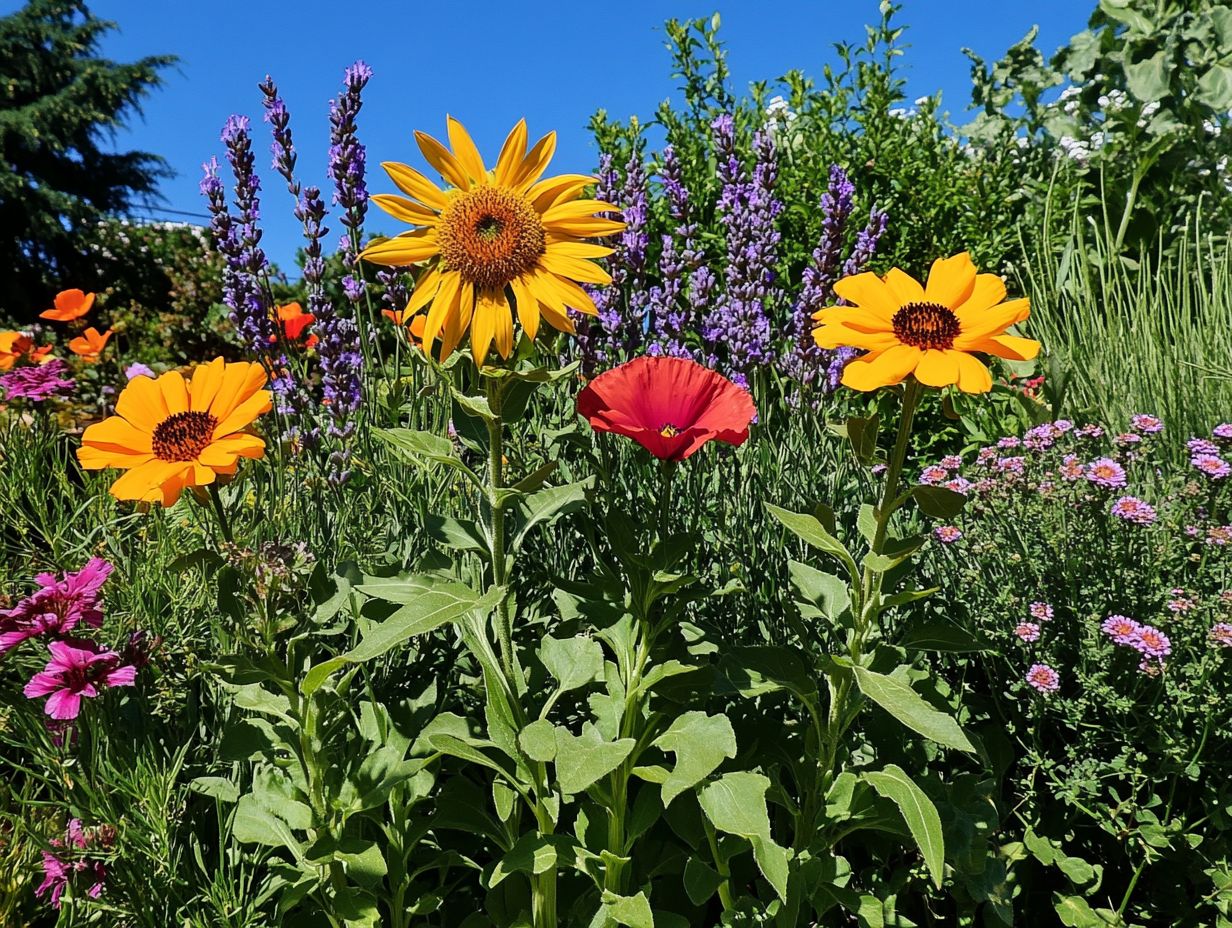
Beyond their impressive drought resistance, flowers like Lavender, Yarrow, and Coneflower offer a multitude of benefits. They attract wildlife, boast fragrant foliage, and contribute significantly to a healthy environment as essential ecological plants.
These resilient flowers do more than survive. They actively support diverse pollinator populations, enhancing the overall biodiversity in your garden. Imagine vibrant bursts of color transforming your outdoor space into a stunning visual retreat.
By drawing in bees, butterflies, and other beneficial insects, these flowers play a vital role in maintaining balance in nature. With their long blooming periods and ability to thrive in challenging conditions, they create an inviting atmosphere for both gardeners and nature lovers.
Choosing these flowers is a feast for the eyes and helps our planet! They not only delight but also nurture the environment.
How Can These Flowers Enhance Your Garden’s Aesthetics?
Integrating drought-resistant flowers into your garden fosters sustainability while elevating its aesthetics with a vibrant palette and seasonal color variations.
This approach gives you the power to craft dynamic, visually striking spaces that evolve with the seasons, drawing in a variety of pollinators while providing an engaging atmosphere.
When considering design strategies, one effective method is to group flowers with complementary colors. Think of vibrant yellows dancing alongside deep purples or soft blues mingling with bright reds.
Layering plants of varying heights ensures that each flower has its moment to shine, contributing to a sense of depth and structure. By carefully selecting foliage, you can enhance the overall scheme, adding texture and intrigue even when blooms are taking a break.
Where Can These Flowers Be Found?
Drought-resistant flowers such as Lavender, Yarrow, and Coneflower are readily available at local garden centers, nurseries, and online retailers specializing in native plants and what are the best drought-resistant flowers for sustainable gardening options.
Exploring these avenues allows you to discover a vibrant selection tailored to your gardening needs. When you visit garden centers, pay attention to the variety available and the overall condition of the plants. Look for robust foliage, healthy roots, and signs of recent care these are indicators of a plant s vitality.
Online platforms offer the convenience of comparing countless options from the comfort of your home. However, it s crucial to read customer reviews and check return policies to ensure a smooth purchasing experience. By investing time in making informed decisions, you can guarantee that the plants you choose will not only thrive but also enhance the resilience and beauty of your garden.
Are There Any Potential Drawbacks to Planting These Flowers?
While drought-resistant flowers bring a wealth of advantages, it’s essential to be aware of potential drawbacks. Specific growing conditions might limit their success or compatibility with other plants, making it wise to seek expert advice before planting.
Understanding the unique needs of each plant is key. Even these hardy flowers can fall victim to pests or diseases that might compromise their resilience. For example, certain drought-resistant varieties may flourish in dry climates but struggle against local insects or root rot.
To effectively address these challenges, you can implement ways to control pests effectively and keep a close eye on your plants for early warning signs. Tailoring your watering schedules and soil amendments to match each flower’s specific requirements can boost their growth and health. This approach ensures a vibrant and enduring garden, even in the face of adversity.
Frequently Asked Questions
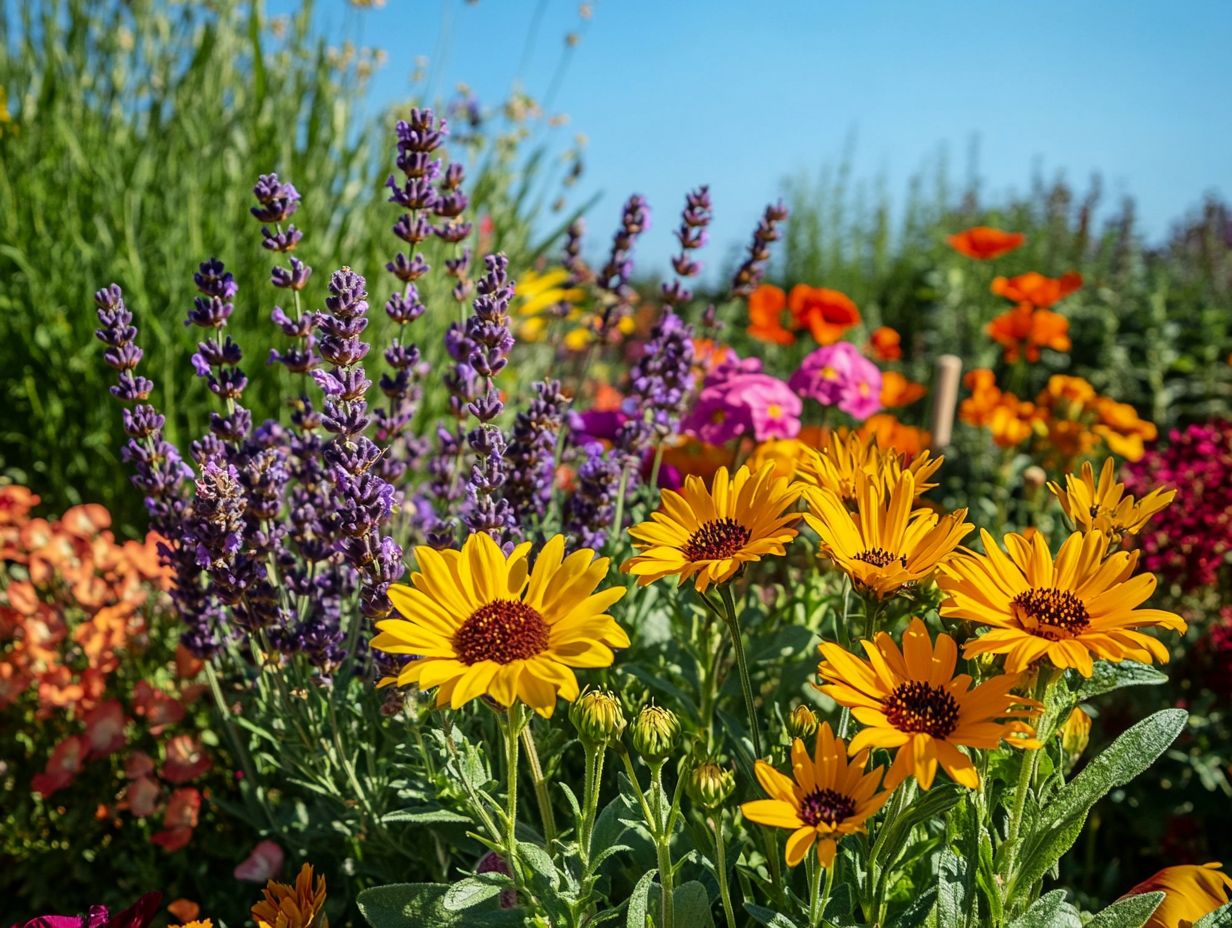
Start creating your beautiful garden today! Don t wait! Transform your garden with these stunning flowers!
What are the top 5 drought-resistant flowers for my garden?
The top 5 drought-resistant flowers for your garden are: Lavender, Black-eyed Susan, Cactus, Yarrow, and Coneflower. For those looking to add variety, consider the top 5 succulents for drought-prone areas, which thrive in hot, dry climates and require minimal water and maintenance.
Why should I choose drought-resistant flowers for my garden?
Drought-resistant flowers are a great choice for your garden. They survive in dry conditions where other plants may struggle, offering top reasons to choose drought-resistant plants, meaning less water usage and maintenance for you.
How should I care for my drought-resistant flowers?
Drought-resistant flowers are low maintenance. To help them thrive, plant in well-draining soil and water deeply but infrequently.
Can I still have a colorful garden with drought-resistant flowers?
Absolutely! You can find many varieties of drought-resistant flowers in a range of colors, from vibrant purples to sunny yellows. Mix in some drought-resistant shrubs and succulents for added color and texture.
Will these drought-resistant flowers attract pollinators?
Yes! Many drought-resistant flowers attract bees, butterflies, and other beneficial insects. This promotes pollination and a healthy ecosystem in your garden.
Are these drought-resistant flowers suitable for any type of garden?
Yes, these flowers are suitable for all types of gardens, whether you have a small balcony or a large backyard. They are also great for a method of landscaping that conserves water, so no matter where you live, these flowers are a wonderful addition to your garden.
Start planning your colorful, drought-resistant garden today!

